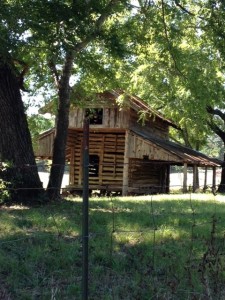On the way to the East Texas Historical Association Conference in September I took a detour down a lonely Farm Road in the northern part of Cherokee County. It was such a lovely day that I decided a little exploration was in order. At one point
I passed this structure.
It definitely deserved a closer look. The building was located in a pasture near the road. Houses were within a half-mile, but not any closer. A few cows grazed nearby.
Quite obviously this was cobbled together in several stages. I suspect that the core of the structure was originally an early 20th century corncrib. Note the lower doorway has three boards running horizontally at the bottom, blocking easy access into the interior for cattle, hogs, horses, and feral animals in the vicinity. Corncribs could be found throughout the rural expanses of the countryside for many, many years.
Farmers raised corn as supplemental feed for livestock and a subsistence crop for their families. As soon as the corn ripened in the field, all hands, including the wife, children and neighbors helped the farmer harvest his crop and store it in the corncrib. Every morning it would be the job of one of the children, an older person, or a boarder to rise early, go to the corncrib, pick up enough ears of corn for breakfast, and shell them. The woman of the house then cooked corn for breakfast, leaving enough to grind into meal for cornbread later in the day. Corn and pork were the staples of pioneer life in America.
Corn was also a cash crop. In the 19th century, North Texas farmers often loaded a wagon full of corn, drove it across the Red River, and sold it to the Federal Agents at one of the numerous Indian Reservations in Indian Territory. Federal gold was better than any other swapping.
A close examination of the photograph indicates that while the corncrib was the center of the structure, some enterprising farmer added at least one or maybe two troughs to each side of the corncrib to feed livestock. Extended overhangs provided protection from rain and storms. Since the timber of the shed is a different material, but the same as the hayloft above, it is entirely possible that this material came from an older farm building torn down before it fell down.
The opening in the upper part of the structure indicates a hayloft, allowing the farmer to toss loose hay into a waiting wagon with a pitchfork. While most farmers used all of the hay they stored, some found it another means of earning hard cash.
At one time, such sites were common in rural Texas. Today, they are captured digitally to record a past way of life. Oh how things change!

